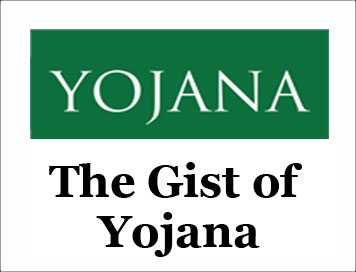(HOT) UPSC Current Affairs 2025 PDF
NEW! The Gist (OCT-2025) | E-BOOKS
(GIST OF YOJANA) SWACHH BHARAT MISSION (GRAMEEN) & JAL JEEVAN MISSION – PAVING WAY FOR VIKSIT BHARAT @2047
GIST OF YOJANA : SWACHH BHARAT MISSION (GRAMEEN) & JAL JEEVAN MISSION – PAVING WAY FOR VIKSIT BHARAT @2047
SEPTEMBER-2025
SWACHH BHARAT MISSION (GRAMEEN) & JAL JEEVAN MISSION – PAVING WAY FOR VIKSIT BHARAT @2047
Context:
In 2014 and 2019, the Government of India launched two of the most defining interventions in the rural development landscape - Swachh Bharat Mission (Grameen) and Jal Jeevan Mission. Neither initiative was framed merely as a service-delivery mechanism for sanitation or drinking water. Instead, they represented a recalibration of governance priorities, aimed at correcting long-standing deficits in public health infrastructure and institutional responsiveness in rural India.
Nature of Interventions
-
Not just service delivery in sanitation or drinking water. Aimed at recalibrating governance priorities in rural India. Addressed long-standing deficits in public health infrastructure.
Governance Philosophy
-
Inspired by the Prime Minister’s motto: “Sabka Saath, Sabka Vikas, Sabka Vishwas, Sabka Prayas”
-
Represents inclusive and participatory governance.
-
Shift away from top-down delivery models towards community-driven action.
Core Principles of SBM-G and JJM
Jan Bhagidari (People’s Participation)
-
Central element of both missions.
-
Communities actively plan, implement, and manage sanitation and water systems.
People-Owned & People-Managed
-
Strength of collective responsibility sustains services and behaviour long after infrastructure is built.
Local Institutions Empowered
-
Panchayats and VWSCs take decision-making roles.
-
Behavioural change embedded at grassroots level.
Swachh Bharat Mission (Grameen): Sustaining the Sanitation Momentum
Achievements in a Decade:
-
Declared India as Open Defecation Free (ODF) by 2019.
-
Sanitation coverage improved from 39% in 2014 to 100% in 2019.
-
Created decentralised systems to adapt to local needs.
-
Community ownership: sanitation understood, owned, and sustained at village level.
SBM Phase II (2020–21 onwards): Focus on ODF Plus Model villages.
ODF Plus Model means:
-
Sustaining ODF status. Proper solid and liquid waste management. Ensuring visual cleanliness in villages.
-
As of July 2025, More than 96% of villages declared ODF Plus. 4.70 lakh villages categorised as ODF Plus Model.
Social and Behavioural Shift
-
Sanitation became a symbol of dignity, equity, and national resolve.
-
Changed relationship between citizen and state.
-
Integrated behaviour changes into rural culture.
Jal Jeevan Mission: Ensuring Water
Security
• Progress and Coverage
• Launched in 2019, to complement SBM-G achievements. By July 2025: Over 15.67 crore household tap connections. It crossed 80% rural coverage.
Empowering women:
-
24 lakh+ women trained with Field Testing Kits for water quality.
-
Women became Jal Sakhis / Jal Sahiyas.
-
From water carriers to water managers.
Schools and Anganwadis:
-
Access to piped water.
-
Healthier and more dignified environments for children.
-
Girls’ school attendance improved due to sanitation & hygiene facilities.
Profound Impact of SBM-G and JJM
Public Health
-
Michael Kremer’s research: Universal safe water access could reduce infant mortality by 30% (~1.36 lakh child deaths annually).
WHO Report:
-
JJM can prevent 4 lakh diarrhoeal deaths.
-
Saves 5.5 crore hours daily (mostly women’s).
-
Economic benefits of ₹8.28 lakh crore.
SBM-G Impact:
-
WHO (2018): 3 lakh diarrhoeal deaths avoided in 2019 vs 2014.
-
Nature (2024): 60,000–70,000 infant lives saved annually.
Women’s Dignity and Empowerment
-
UNICEF/BMGF Study (2020): Household toilets enhanced Suvidha (convenience), Suraksha (safety), Swabhimaan (self- respect) of rural women.
-
Reduced need for women to walk long distances for sanitation or water.
Environment and Hygiene
-
UNICEF Study (2018–19): Groundwater in ODF villages was 12.7 times less contaminated compared to non-ODF villages.
Employment Generation
-
Construction phase created: 60 lakh person-years of direct employment. 2 crore person-years of indirect employment.
Localised Successes
-
Revived dormant water schemes through Gram Panchayat mobilisation.
-
Tribal communities built water testing and distribution systems.
-
Women trained as pump operators – breaking traditional hierarchies.
SMART Vision for the Future of SBM-G Sustainability of Assets and Behaviours:
-
Shift from infrastructure to systems management.
-
Importance of O&M protocols, funding at Gram Panchayat level.
Innovations:
-
Greywater reuse (Tamil Nadu).
-
Soak pit standardisation (Rajasthan).
-
Community O&M models (Kerala, Sikkim).
M – Making Women Central
-
Women as Rani Mistris, Swachhagrahis, SHGs, Jal Sakhis.
-
SHG-led enterprises: sanitary pad production (Odisha), faecal sludge management (Telangana).
-
Sanitation as income and leadership opportunity.
A – Accelerating Private Sector Role
-
Private sector in waste management & circular economy.
-
GOBARdhan units integrated with dairies (Maharashtra, Gujarat).
-
Potential for CSR-backed projects and sanitation incubators.
R – Re-establishing Communication
-
Communication central to SBM-G’s success.
-
Next phase: awareness about pit emptying, menstrual waste disposal, segregation.
Alignment with Sustainable Development Goals (SDGs)
-
SDG 6: Clean water and sanitation – directly addressed.
Other SDGs indirectly advanced:
-
SDG 3: Health (reduced mortality).
-
SDG 4: Education (girls’ attendance).
-
SDG 5: Gender equality (women’s empowerment).
-
SDG 8: Decent work (jobs in sanitation/water).
-
SDG 13: Climate action (resilient WASH systems).
Four Strategic Shifts:
-
Tap Coverage to Water Security
-
Hydro-geological mapping.
-
Springshed development in Himalayas.
-
Aquifer recharge & rainwater harvesting.
-
Initiatives: JSA: Catch the Rain & Jal Sanchay Jan Bhagidari.
Infrastructure to Innovation.
-
IoT-based water monitoring.
-
Climate-smart villages.
Silos to Synergy
-
Convergence with health, nutrition, education, and agriculture.
-
Greywater irrigation for kitchen gardens.
-
Improved nutrition and reduced stunting.
Way forward and Conclusion:
The enduring lesson of SBM-G and JJM is that systems can shift when society aligns with purpose. The next chapter of rural WASH must build on this foundation, one that empowers Panchayats, repositions women, incentivises innovation, and integrates climate resilience into water and sanitation.
India’s rural WASH story is not over. It is simply entering its most critical and catalytic phase. The road ahead demands vigilance on inclusion, on sustainability, and on deepening participation. And as we march towards 2047, it is this phase that will define whether we remain a service delivery state or become a truly self-reliant, Swachh and Viksit Bharat.
CLICK HERE TO DOWNLOAD FULL PDF
CLICK HERE TO DOWNLOAD UPSC E-BOOKS
Study Material for UPSC General Studies Pre Cum Mains
Get The Gist 1 Year Subscription Online
Click Here to Download More Free Sample Material
<<Go Back To Main Page
Courtesy: Yojana



